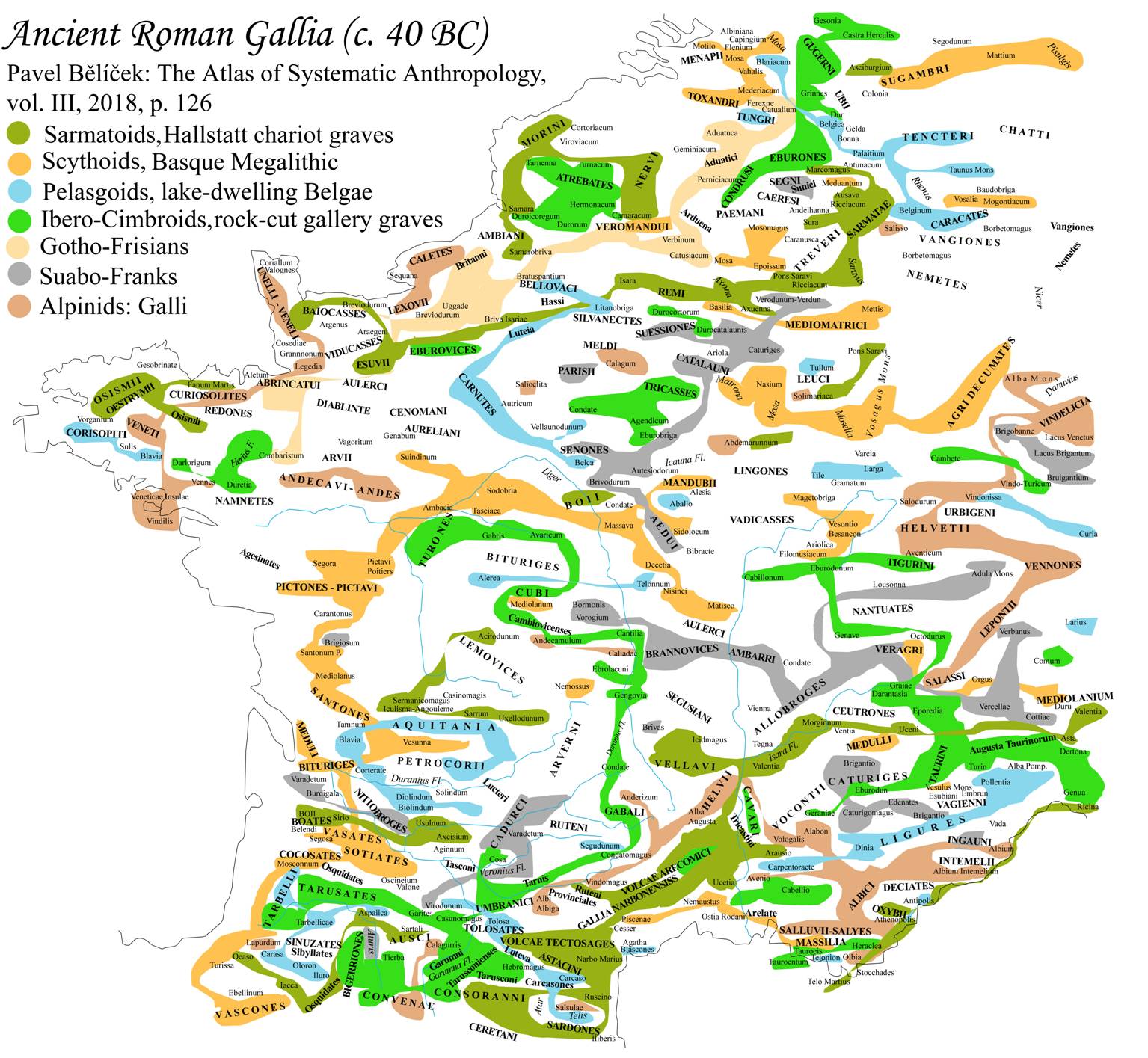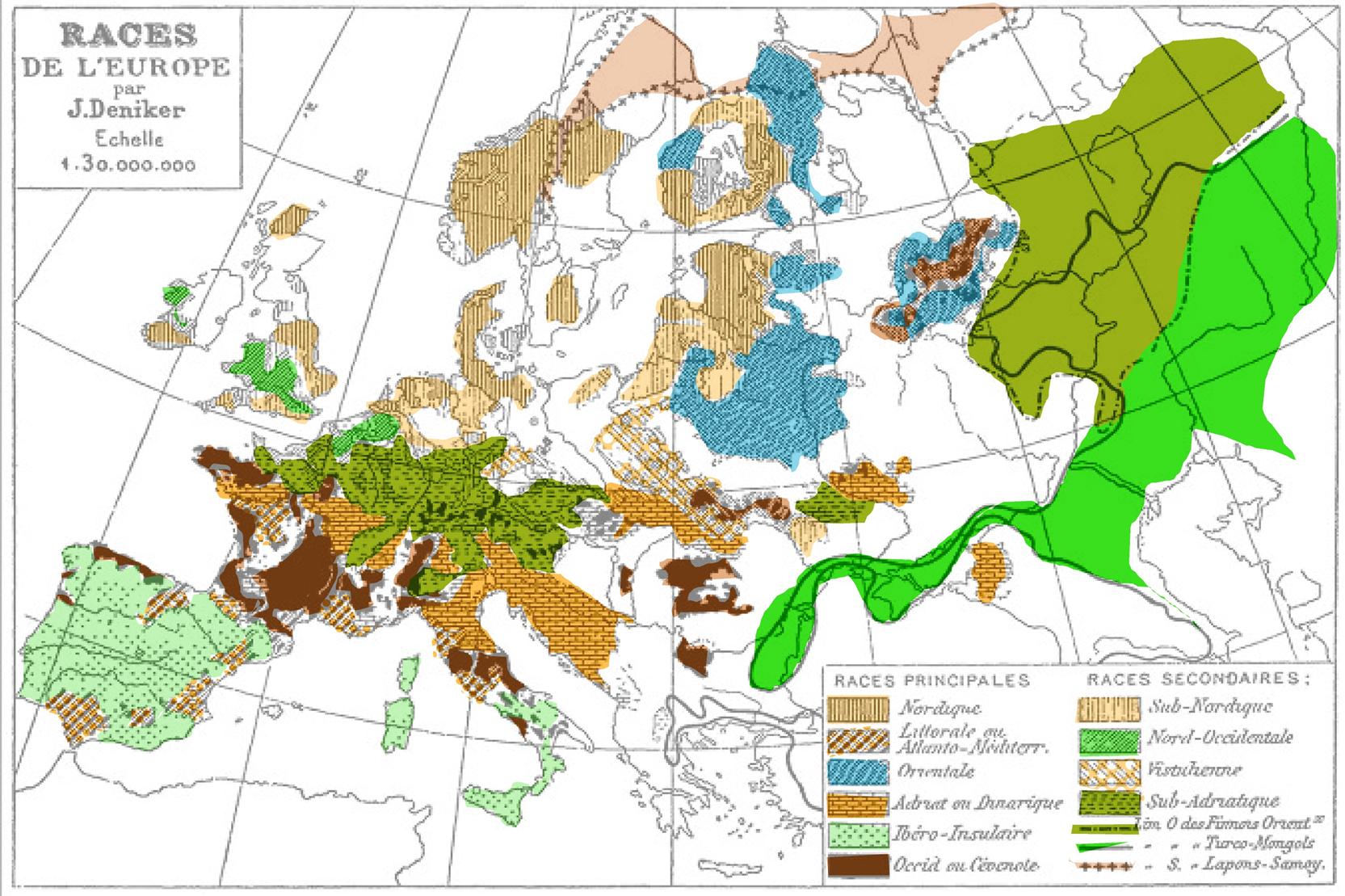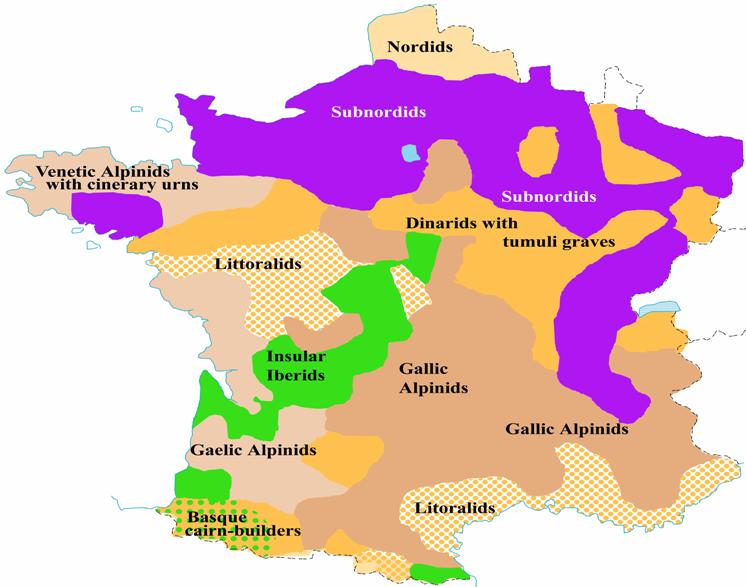|
|
|
||||||||||||||||||
|
|
|
||||||||||||||||||
|
|
|
|
|||||||||||||||||
|
|
|
|
|||||||||||||||||
|
|
|
|
|||||||||||||||||
|
|
|
||||||||||||||||||
|
|
|
|
|||||||||||||||||
|
|
The
tribes of ancient Gallia The clickable terms are red on the yellow background |
|
|
||||||||||||||||
|
Ancient Gauls (from P. Bělíček: The Analytic Survey of European Anthropology, 2018, p. 126) |
|||||||||||||||||||
|
Map 32.
Racial map of Legend to Map 32:
|
|||||||||||||||||||
|
|
Tab 33. The
distribution of races in France (after G. Montadon)
The Archaeological Disambiguation of
Ancient Romance Tribes
The complex of Romance
peoples calls for a detailed dissection that might elucidate the anatomy of
their inner ethnic factions. The very term ‘Romance’ is a controversial
misnomer because its originators were the Roman Marsi,
Sabini and Samnites,
who descended from the Hallstatt horseback riders
of Sarmatian origin. They imported the advanced
Iron Age metallurgy to Hallstatt Sarmatids were not populous enough to give the IE
language structures a definite Iranian and Uralic stamp, and so they were
soon outnumbered by Gallic Celts and Iberian Mediterranids.
As a result, in Italic, Gallic and Iberian languages the strong Celtic
element prevails over Sarmatic
peculiarities. When we abandon the pointless concept of the Romance family, it may
be replaced by more suitable terms of Gallo-Romans of Tardigravettian
origin. Its complex may however be analysed also as a part of the Epi-Aterian family or Epi-Magdalenian
domain. Arguments for the former solution are that Arabic, Iberian and Italic
languages group share one category of determination with very similar systems
of definite and indefinite articles: French le, la
– un, une and Italic il, lo – uno
as compared to Arabic al- or el
– -n. Articles represented a typical non-IE import of
European Bascoid megalith-builders, who shared k-plurals
and definite articles in -k with Abkhaz kurgan-builders.
Epi-Aterians. The idea of Epi-Aterian family or Basco-Scottish
family is based on the structural unity of West-European megalith cultures,
whose patterns were closely associated with the Berber megalithic complex in Another viewpoint open to disputes
speculates that the Chalcolithic megalithic
builders may be remote descendants of the Lincombian-Ranisian-Jerzmanowician, Solutrean, Aterian, Szeletian people of
Mousterian origin. They lived in caves, applied leaf-shaped lance-heads and
buried the dead under piles of stones in front of their cave abodes. These
cavemen were immiserated hosts of mammoth-hunters
who wandered in quest for their herds to Mario Alinei’s
Palaeolithic Survival theories have breathed new life into diffusionist thought and make it possible to link
prehistoric ancestors with modern survivors. They consider links between Aterians (30,000 BC), Basques and Berbers, who developed
similar leaf-shaped lance-heads and funeral architecture with round
dome-shaped mounds. Leaf-shaped points were cultivated also by Solutrean horse-hunters (18,000 BC) and flourished also
in Lincombian, Ranisian and Jerzmanowician sites (43,000 BC) in
The predecessors of western megalith-builders may have colonised their
Atlantic sites in waves of several prehistoric colonisations: * Aterian (c. 145,000 BP – 30,000 BP)
was a Middle Stone Age industry jutting out of * Mousterians (70,000 BP) represented a
Neanderthal culture extending from western * Châtelperronian
(44,500 – 36,000 BP) was formed by a Mousteroid
culture of denticulate tools that were situated in * Solutrean (22,000 BP), a culture of horse hunters with
leaf-shaped and pressure-flaked industry. It was located in western * The advent of the La Hoguette megalithic culture (4900 BC) in * The Andalusian Neolithic (c. 4800 BC)
introduced the first dolmen tombs in southeast * The Chalcolithic Almerian culture (3600 BC) with megalith constructions that
were lining the eastern coasts of * The Los Millares culture (2900 BC) developed a higher stage of the Almerian tradition of megalith-building architecture as
its direct descendant. It prided on large concentric cupola-shaped mounds. *
The VNSP or Castro of Vila Nova de São
Pedro culture (2700 BC) exhibited the mainstream of Iberian
megalithic cultures importing the typical castro
type of fortified oppida. Its architecture gave
preference to circular roundhouses with round walls roofed by conical wooden
construction. *
The nuraghe (Sardininia, 1900 BC) and
talaiot ( |
|
Franco-Swabian
Dolichocephalous Littoralids Franco-Swabian dolichocephals. As far as populousness is concerned, the
second position in the census of Campignian
Littoralids. Epi-Aurignacian fishers searched for lakes in lacustrine localities
and plain depressions below sea level, whereas Epi-Cardial fishers contented
themselves with seaside deep water shores suitable for harbours. Cimbrian,
Etruscan and Punic pirates preferred rocky cliff-dwellings along narrow
straits and dolichocephalous Littoralids favoured sand dune beaches full of washed-up shellfish.
Archaeologists pay less heed to their Late Mesolithic predecessors denoted as
Campignians (12,000 BP). Their type site was situated in Le Campigny along the Seine Inférieure.1 Its nearest relatives were found in
the Asturian culture (9280 BP) settled
in Eastern Austuria and Western Cantabria. Asturian sites were linked
with the contemporary Muge culture in the Tagus Valley in Portugal. Both
localities were noticeable for finds of pick-axes, whose heads were attached in a perpendicular
direction to the handle. Another
typical product of Campignians was the large
hand-axe that gave them the nickname of ‘men of the halberd’.2 The second phase of
the Campignian civilisation is referred to as Robenhausean culture. Its
typical left-overs were shell-middens, known as kjökkenmöddinger in Denmark in Spain and as concheros in Spain. They looked like heaps
of waste and kitchen refuse thrown out of windows of longhouses. Its debris
were piled up and formed mounds of sand dunes dubbed as ‘raised
beach’. This life-style characterised
them as beachcombers and shellfish eaters. Their northern outposts were excavated in the Nøstvit culture near Antrim beech in south
Norway. Their westernmost seats were dug up in the
The inner taxonomy of Gothoid tribes may be
set up by using data of population genetics. According to the high rates of
the Y-DNA haplogroups I1 and I2 in Map 34, it is
possible to distinguish several filial plantations of Neolithic farmers with
the Y-haplotype I. Their leading dominant was
formed by the Danubian Linear Band Culture with the
haplotype I2. Its people managed to avoid Germanisation
brought about the avalanche of Tardenoisian and Beuronian
microlithic cultures from the east. They were IE Gothids preserved under the umbrella of Slavonic Subnordids. Their fraternal civilisations with the Y-DNA
J operated in southern The
Phenotypes of Racial Groups in
French anthropology
was studied in detail by the famous naturalist Joseph Deniker
of Russian origin. He opposed racism and proposed to treat races as equal
nationalities and ethnic tribes. In his Races et peuples de la terre (1900) he
classified Iberian Mediterranids as race
ibéro-insulaire, Alpinids as race cévenole
and Franco-Swabians on coastlines of the Balearic
and Epi-Cardial Fishers. The southern parts of Epi-Aurignacian Mediterranids. Descendants of Aurignacian colonisations differed from the Epi-Cardial progeny by constructing rectangular
stilt-huts and post-dwellings. Such a rectangular make-up characterised
especially the Chasséen complex (4500-3500 BC). It got
its name from the type site near Chassey-le-Camp in the
Saône-et-Loire department. Its architecture with dammed settlements on
vertical piers and platforms on horizontal trunks looked similar
to two contemporary Swiss groups: the Cortaillod Culture (4300-3900 BC) in
the west and the Pfyn assemblage (3900-3500 BC) in the east. Their daugherly
derivations appeared in the Lombardian and Venetian Polada culture (2200
to 1500 BC). Its younger continuation
loomed in the Terramare technocomplex (1700-1150 BC) in the Bell-Beaker Folk. Campignian shell-fish eaters later turned into the
culturally advanced Bell-Beaker Folk and Franco-Swabian
frog-eaters. Their seats and travels are sketched in Map 31. It illustrates
the spread of the Beaker Folk by terms of chronological data in violet
colour. In addition, it matches its tribal colonies (orange colour)
with ethnonymic groupings recorded in maps by
Ancient Roman geographers (black colour). The
Beaker Folk lived in long communal houses and excelled in high maritime
mobility. Their beachcombing life-style promulgated the Gothoid
white-skinned race and campaniforme pottery along
the eastern coastline of African as far the Cap of God Hope. About 2500 BC
their hosts landed on the
Trichterbecherkultur. The Beaker Folk settlements often ran across the sites of the
Funnelbeaker culture (Trichterbecherkultur, 4300 BC) in North Europe.
Its core seems to have grown out of the local Gothoid handaxe traditions and
suggests association with the Rugians. Their ceramic style was soon affected by the influx of
megalithic dolmen burials inspired by techniques of the Globular Ware
pottery. Its main tribal branches are linked with ancient Rugii
and Pomeranian Rugini. In Britain they left several
promising ethnonyms such as Ragae and Rigodunum. Since their phratries often
included the tribes of Senones, they may be associated with the
British Cenimagmi. One of their affiliated clans resided also in the Seine-et-Marne department. Megalith mounds have to be considered as a
higher stage of simple pile-burials and straw beehive huts in the period when
Scythoid chieftains began to subdue neighbouring
tribes and acquire greater social influence. They spread from Campignian Littoralids. The first Gothids with the Y-haplogroup
I1 came to
|
|
|||||||||||||||



